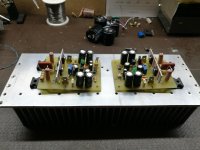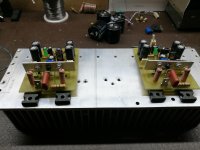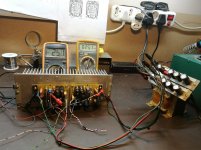Here's the rule of thumb I've used for the projects I've built:
One of the most critical factors is the orientation of the fins. I can't tell in your pictures whether they run the long dimension of the heat sink (I'll call it "the lenght"), or whether they run the short dimension of the heat sink (I'll call it "the width"). Regardless, when you install the heat sink on the chassis you want to make sure the fins are oriented vertically when the chassis is in operation.
The object of the game is to create a convection engine, where the bottom of each fin is relatively cool and sits in relatively cool air. The devices you want to keep cool are mounted at approximately the half way point from the bottom of the fins, give or take maybe 20% lower. That means you can mount the devices approximately 20% lower than halfway if you need to, but try not to go higher than half way.
As the devices get hot, they pass the heat on to the heat sink and then to the fins. They will get a bit warm below the devices, but most of the heat will rise to the top half of the fins. That creates a system where cool air passes the bottom of the fins and is pulled upwards across the upper half of the fins, carrying the heat away and cooling the overall heat sink. That self-pulling air mechanism is your convection engine.
Here's an example for you -- If your heat sink has 4 inch fins, you can mount the active devices anywhere from say.........1.5 inches from the bottom of the fins to the two inch mark.
Hope this helps.
Dave
One of the most critical factors is the orientation of the fins. I can't tell in your pictures whether they run the long dimension of the heat sink (I'll call it "the lenght"), or whether they run the short dimension of the heat sink (I'll call it "the width"). Regardless, when you install the heat sink on the chassis you want to make sure the fins are oriented vertically when the chassis is in operation.
The object of the game is to create a convection engine, where the bottom of each fin is relatively cool and sits in relatively cool air. The devices you want to keep cool are mounted at approximately the half way point from the bottom of the fins, give or take maybe 20% lower. That means you can mount the devices approximately 20% lower than halfway if you need to, but try not to go higher than half way.
As the devices get hot, they pass the heat on to the heat sink and then to the fins. They will get a bit warm below the devices, but most of the heat will rise to the top half of the fins. That creates a system where cool air passes the bottom of the fins and is pulled upwards across the upper half of the fins, carrying the heat away and cooling the overall heat sink. That self-pulling air mechanism is your convection engine.
Here's an example for you -- If your heat sink has 4 inch fins, you can mount the active devices anywhere from say.........1.5 inches from the bottom of the fins to the two inch mark.
Hope this helps.
Dave
I like the second one better, as it avoids fin-sharing and distributes the heat better along the full breadth of the whole hs. This is assuming we are looking at the hs from the underside. It's not ideal though, as the transistors are a bit close to the bottom edge, but it's still intuitively better than the first option...
Neither of them is great, the main thing is to have the transistors as even spaced as possible. It would be better if in the first picture one board was rotated 180 degrees and then them both shifted across to get the transistors nearer the centre
The transistors should be in the middle of the heat sink so there is most metal beneath them.
Given there are two modules then they need to be apart from each other.
So the first picture is the way I would go but with the pcb's slightly closer together.
Given there are two modules then they need to be apart from each other.
So the first picture is the way I would go but with the pcb's slightly closer together.
I like the second one better, as it avoids fin-sharing and distributes the heat better along the full breadth of the whole hs. This is assuming we are looking at the hs from the underside. It's not ideal though, as the transistors are a bit close to the bottom edge, but it's still intuitively better than the first option...
I like this one too.
- Status
- Not open for further replies.
- Home
- Design & Build
- Construction Tips
- Mounting of modules on heatsink


